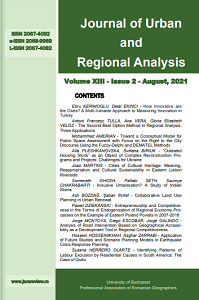IDENTIFYING PATTERNS OF LABOUR EXCLUSION BY RESIDENTIAL CAUSES IN SOUTH AMERICA: THE CASE OF QUITO
IDENTIFYING PATTERNS OF LABOUR EXCLUSION BY RESIDENTIAL CAUSES IN SOUTH AMERICA: THE CASE OF QUITO
Author(s): Susana Herrero OlarteSubject(s): Human Geography, Labor relations, Rural and urban sociology, Economic development
Published by: Editura Universitară
Keywords: urban poverty; labour exclusion; urban mobility; Quito;
Summary/Abstract: The lack of opportunities for employment is still present in most South American cities. This arises as a problem due to its impact on chronic poverty and social mobility, two of the main challenges in the region. Therefore, the aim of this paper is to identify the causal link between residential location and labour market exclusion, and its effects on development, geography, and urbanism. This paper uses an urban mobility approach to define the geographic poverty pattern and to generate new tools for the development of local policies in Quito. It also delves the lack of opportunities to access employment, as representing the main source of urban poverty growth in South America, especially due to residential location. The analysis applies the Multidimensional Poverty Index (MPI) and the Labour Exclusion by Residential Causes Index (LERCI) to each Quito parish. LERCI includes variables of distance, cost, and public transportation density. Our results regarding the correlation between the two indices suggest a pattern of labour exclusion by residential causes that includes two different dimensions of urban poverty – one in downtown parishes and the other in the periphery.
Journal: Journal of Urban and Regional Analysis
- Issue Year: 13/2021
- Issue No: 2
- Page Range: 401-415
- Page Count: 15
- Language: English

